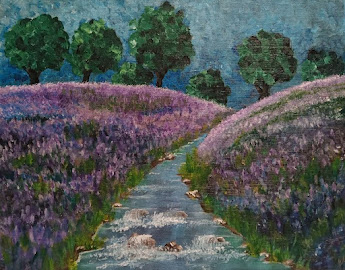These impressionistic gems were created by artists in our Art Class for Grownups, most of whom having little to no past canvas painting experience.
What is Impressionism? Claude Monet, often considered the first impressionist, described the creation process in this way:
"When you go out to paint, try to forget what objects you have before you, a tree, a house, a field... Merely think, here is a little square of blue, here an oblong of pink, here a streak of yellow, and paint it just as it looks to you, the exact color and shape, until it gives your own naïve impression of the scene before you."
For beginning painters, impressionism can be satisfying and fun because the burden of attempting to paint objects realistically is removed. Instead, we paint our personal impression of what is seen.
We are simply painting shapes and color and light.
An impressionistic painting can be almost dreamlike or based on a memory of a scene: what do I remember about this special place?
Perhaps the trees along the horizon, the colors of the flowers, the sky reflected in the water. Simplifying the scene becomes part of the process.
We then painted the sky and the background along the horizon, using small filbert brushes and choppy, bold brush strokes.
We continued downward, starting with the distant flowers and moving forward while depicting more and more detail in the midground and in the foreground.
We then created the flowing water by randomly painting in our sky colors (again starting at the top and working downward). While still wet, we stroked the paint lightly downward, then across with a dry clean brush for reflections in the water. Then we added some rocks, a few waterlines along the edges, and some white water and splashes.
Painting these little landscapes helped artists learn to:For more about Impressionism and painting flowers in this style, please see our previous weblog post: Tuscan Colors Like the Impressionists









No comments:
Post a Comment